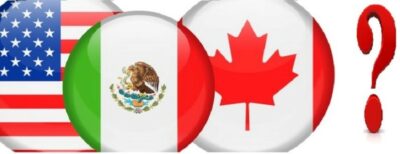By Bob Brewer, VP Marketing, BLG
Honestly, the odds of President Trump pulling the U.S. out of NAFTA, in my opinion, was rather inflated. It’s simply a tactic in the “art of the negotiation”. Vegas odds of President Trump leaving the North American Free Trade Agreement have now dropped sharply, trade observers say, but the U.S., Canada and Mexico are still sharply at odds over (3) key sticking points.
Are we at an impasse? No, but the latest round of talks have apparently made very little progress towards resolving the biggest issues.
First, the U.S. wants a clause that would effectively terminate NAFTA every five years, but that’s a deal breaker for Canada and Mexico. Canada has offered the opportunity to revise the deal every five years instead, which of course brings everyone back to months of renegotiation, with too much at stake once again. Revisions themselves, given the scope, need to be given enough time to develop before deciding on whether they are successful or not, and many times, 5 years is just not enough. Look how long NAFTA itself has been in place, (1994) and 24 years later, we are still debating on what is, or isn’t, effective, and fair trade between all (3) countries.
Second, another major change sought by the White House is the manner in which NAFTA calculates the regional content of where a new car or truck is manufactured. That affects whether a vehicle is considered “made in America” or labeled an import. This is no small consideration since Mexico is the largest provider of auto parts to the United States, and the United States is the largest provider of auto parts to Mexico. Mexico exports roughly $46 billion in auto parts to the U.S., while the U.S. exports an estimated $20 billion in auto parts annually to Mexico. It’s co-production ladies and gentlemen, which cannot easily be “undone” as roughly $3800 in Mexican parts per car go into each vehicle made in the U.S., and an estimated $5,500 in U.S. parts per car go into each vehicle manufactured in Mexico. So, they are actually all, “Made in North America.” If the Trump administration got its way the effect would be to pressure auto makers to shift a lot more production to the U.S. from Canada and Mexico, an outcome neither of those two countries is willing to accept.
The third dispute centers on how to resolve trade conflicts between the countries. The U.S. basically wants to cut out the middleman — arbitration-dispute panels whose results are binding and outside the purview of the U.S. court system. Pursuant to the NAFTA, the Parties have established several rosters of individuals from which panelists are appointed to settle disputes. It has been mandated, that members of these rosters are of good character, high standing and repute, and have been chosen strictly on the basis of objectivity, reliability, sound judgement and with a general familiarity with international trade law. Currently, there are NAFTA rosters (one per country) for Chapter 11 (Investment), Chapter 14 (Financial Services), Chapter 19 (Antidumping and Countervailing Duty Matters and Extraordinary Challenge Procedure) and Chapter 20 (Institutional Arrangements and Dispute Settlement Procedures). If you’d like more detailed information on the subject, and the 12 step year-long resolution program with Chapter 19 disputes, here is a link to the overview of the dispute settlement provisions for NAFTA: https://www.nafta-sec-alena.org/Home/Dispute-Settlement/Overview-of-the-Dispute-Settlement-Provisions.
New talks are slated for late February in Mexico and President Trump has recently acknowledged that he’s facing a lot of pressure from fellow Republicans and business groups to stay in the trade pact.
The influential Business Roundtable, for example, argued in a report last week the end of NAFTA would cost the U.S. 1.8 million jobs, while some argue that it would actually be 5 million lost jobs.
“We urge the administration to take into account the potential damage of withdrawing from NAFTA, and to focus instead on modernizing the agreement so that it remains a cornerstone of American prosperity,” said Joshua Bolten, President of the round table and former chief of staff for President George W. Bush. The fact remains, President Trump is more than willing at this point to not pull out of NAFTA with the upcoming Mexico election. The last thing the White House needs right now is an incoming Mexico President who isn’t willing to negotiate at all.
“There is a self-imposed deadline to reach a deal by the end of March 2018, although the three countries have expressed flexibility on timing, so that talks can be extended beyond March,” Bank of America said. “Our baseline continues to be bumpy and lengthy negotiations, meaning we expect more posturing down the road, especially before each new round, and talks to be extended for months.”
One final note worth mentioning is that the parties announced their completion of a new NAFTA chapter, titled “Transparency and Anti-Corruption.” There are few specifics to date made public, but apparently it has been structured to establish measures tougher than those within the TPP, and would be enforceable under a dispute resolution mechanism. Mexico is attempting, through the anti-graft chapter, to reassure companies investing and doing business there and to attract new investment. The country ranked 123rd out of 176 in Transparency International’s Corruption Perceptions Index in 2016, behind nations including Brazil, Italy and Pakistan. The U.S. and Canada were likewise interested in establishing the chapter to ensure fair treatment and opportunity for their companies.

























